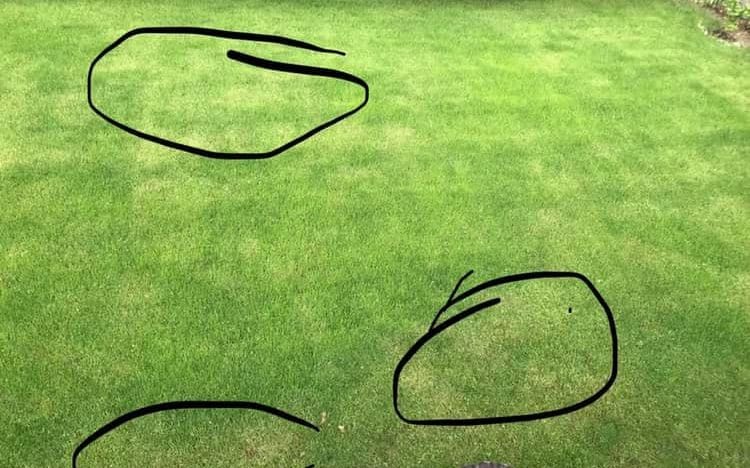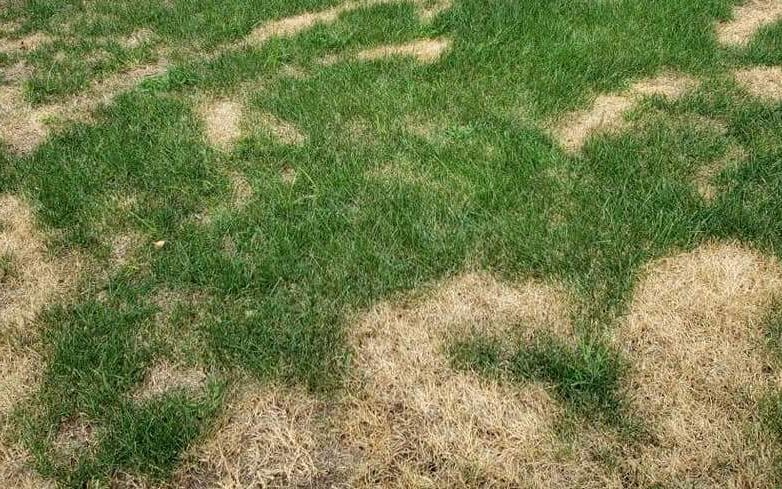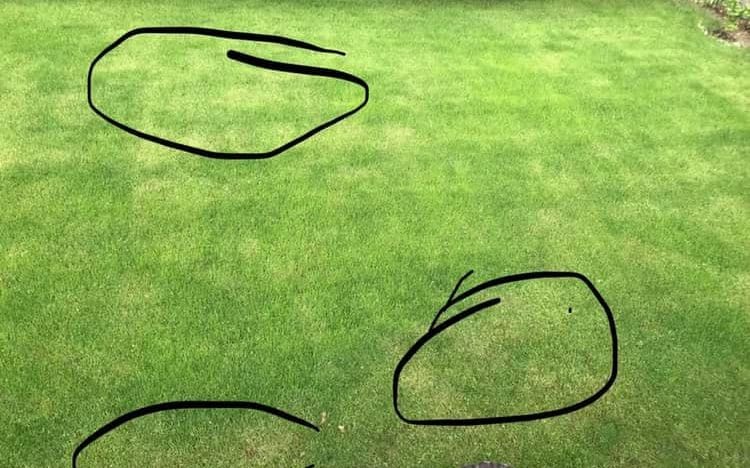You must put in the work to have that green, healthy, full lawn without patches, but what does caring for my lawn entail, you may ask?
Besides watering it properly and mowing well, you must also feed your grass, which sometimes presents unintended results, with your grass turning yellow after fertilizing.
Yellow grass isn’t appealing, and you must combat the discoloration to restore your lawn.
However, it’s also essential to know why your grass turned yellow after fertilization because the grass in your yard shouldn’t be yellow but rather green.
Yellowing grass typically signifies a problem, so don’t ignore it once you notice your grass is changing from green to yellow.
Also Read: Why is my grass turning yellow
Why is Grass Turning Yellow After Fertilizing?

Grass turning yellow after fertilization it’s likely suffering from fertilizer burn. This condition isn’t the same as leaf scorch but is characterized by intense dehydration because of too many nitrogen salts.
The best fertilizers for your lawn usually contain potassium (K), Nitrogen (N), and phosphorus (P) which help your grass grow and stay healthy.
Additionally, some fertilizers have soluble salts, which puts your grass at risk of fertilizer burn.
Read more:
Applying excess fertilizer either accidentally or intentionally causes salt build-up, which in turn leads to fertilizer burn. You will notice your grass turning brown, yellow, or streaked when this happens.
Quick-release fertilizers are more likely to cause fertilizer burn than slow-release fertilizers because they flood your lawn with nutrients at once.
Can Fertilizer Burn Grass?
Yes, too much nitrogen in fertilizer can burn grass since it makes the soil acidic, inhibiting your lawn’s ability to absorb water. This results in yellowing grass, but you can rectify the problem by watering your lawn after fertilizing.
Strive to have the soil wet to allow the water to wash away the excess nitrogen. The moment you notice the signs of burned grass from too much fertilizer, water your lawn generously to prevent more damage.
You will need to soak the affected grass every day for about seven days to help restore the grass’ green, healthy color. Examine your lawn after some time to see if you fixed the problem.
Read more: Why does some grass appear greener than others
Signs of Over-fertilized Lawn
Overfertilization occurs when you apply excess fertilizer to your lawn. While you may be tempted to use more fertilizer in an attempt to provide more nutrients to your grass, that is a terrible idea that will have dire effects.
It’s vital to stick to the recommended amounts of fertilizer for your lawn size. However, you could accidentally use too much fertilizer, so you should know the signs of overfertilizing in order to act swiftly to correct your mistake.
Therefore, the signs of over-fertilized grass are:
1. Burnt Grass
Over-fertilizing can cause the grass blades to dry out and turn yellow or brown, which appears as if they have been burnt.
2. Excessive Growth
An over-fertilized lawn can experience rapid and excessive growth, which may result in the need for frequent mowing.
3. Patchy Grass
Over-fertilization can cause patches of grass to die, leaving bare spots in the lawn.
4. Weak and Brittle Grass
Over-fertilization can weaken the grass roots and make the blades brittle, which makes the grass more susceptible to damage from pests, diseases, and foot traffic.
5. Fungal Growth
Over-fertilization can lead to the growth of fungus and molds, which can damage the lawn and create a musty smell.
6. Slow or no grass growth
Like any other vegetation, grass requires the correct amount of nutrients for proper metabolism and growth. Therefore, overfertilizing causes nutrients imbalance leading to no or slow growth progress.
You may have overfertilized your lawn if the grass isn’t growing in the right place.
7. Fertilizer crust build up on the surface of the soil
If your grass fails to absorb the minerals in the fertilizer, you will likely see a crust of fertilizer forming on the surface of the soil.
This indicates that you applied too much fertilizer on your lawn, making it difficult for the roots to absorb all of it.
Pictures of Over Fertilized Lawns
Will Overfertilized Grass Grow Back?
Yes, overfertilized grass will bounce back if cared for properly, but before reviving it, you must ensure it’s still alive because dead grass will not grow back.
Typically, you can recover your grass if they only have brown and yellow streaks, while you will have to replant if your grass is crunchy and brown.
If it’s in the summer, you will need to wait for the storms in later summer to see if some green shoots emerge on your lawn. This is because determining whether your grass is dormant or dead during this season is challenging since both cases appear virtually identical.
How To Treat Fertilizer Burn On Grass
It would be best if you took the appropriate actions to treat your grass from fertilizer burn the moment you diagnose the problem. Below is what you will need to do.
1. Stop fertilizing the grass momentarily
It’s time to stop fertilizer application when the grass blades change color from green to yellow.
Besides stopping more fertilizer from going into the soil, this step will also serve as a reminder to follow the instructions when applying fertilizer.
2. Water adequately
In the same way you would stop something burning using water, watering is also the best way to stop fertilizer burn. Water your yellowing lawn adequately to stop further deterioration but be careful not to overwater your grass.
For the best chance of saving your grass, apply a generous amount of water daily for a minimum of 7 days, preferably in the morning. The water will help wash away the chemicals.
3. Remove grass clippings and fallen leaves
Grass clippings and fallen leaves decompose, providing your grass with nutrients and thus serving as natural fertilizers.
However, they also carry disease and provide pests with breeding spots, so you must rake grass clippings fallen, and leaves decompose diligently, especially if your grass is yellowing.
4. Aerate your lawn
Aerating your lawn is paramount because your burnt grass requires adequate oxygen to grow back. Aeration ensures proper oxygen circulation, particularly in the roots of your grass.
In addition, ensure your lawn has proper drainage.
5. Mow your lawn
The blades will likely cover the roots or the shorter grass when your grass becomes longer, inhibiting them from receiving sunlight. Adequate sunlight is of utmost importance for the growth of your lawn; hence mowing is a crucial step.
6. Fertilize appropriately
You will have successfully restored your lawn once your grass reverts to its original color. The next step will be to apply the correct amount and type of fertilizer to your yard.
Read more: Should you fertilize new sod
Can Liquid Fertilizer Burn Grass?
Yes, liquid fertilizer can burn your grass if you apply a lot in a single spot. Therefore, spread the right amounts evenly throughout your lawn for the best results.
Conclusion
To wrap up.
Grass turning yellow after fertilization it’s likely suffering from fertilizer burn. This condition isn’t the same as leaf scorch but is characterized by intense dehydration because of too many nitrogen salts.
Even the healthiest lawn can suffer the effects of overfertilizing, but this is something you can easily prevent. Seeing your grass turning yellow after fertilizing is frustrating, so always apply the correct amounts of fertilizer.
Reference
- Clemson Extension Home and Garden Information Center – Fertilizing Lawns
- University of Minnesota Extension – Fertilizing lawns

Hey there, I’m Derek Schew, a writer for Lawnholic.com, where we cover everything and anything related to lawns. As someone who’s spent countless hours tending to my own lawn, I’m passionate about sharing my knowledge and helping others achieve the perfect yard. From lawn care tips to product reviews, I’m committed to providing our readers with the most accurate and up-to-date information available. So whether you’re a seasoned lawn enthusiast or just getting started, I invite you to join our community and discover the joys of a lush, green lawn.


